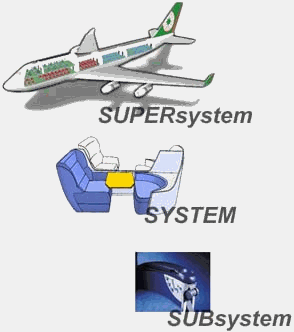
School of Mechanical Engineering, University of Bath,
Claverton Down, Bath, BA2 7AY, United Kingdom
Author: Sam Carter, Supervision: D.L.Mann@bath.ac.uk
This body of work was undertaken as a four-month final year project for an Engineering student under the tutelage of Darrell Mann at the University of Bath. The following article is therefore condensed from a larger report entitled “An investigation into new approaches to the design of economy flight cabins”, available at the university.
1. INTRODUCTION and BACKGROUND
Aircraft passenger flight at its first inception in the 1910’s and 20’s was a luxury afforded to few and conditions for passengers were primitive and uncomfortable. However, the swift technical development of aircraft and in particular, propulsion systems, during this period allowed for the use of progressively larger payload bays and therefore greater opportunities for air transport companies. By the early 1950’s the jet engine had been introduced to commercial aircraft and airlines thus recognised that the economics of flight now favoured cheap fares and increased throughput. Passenger numbers since have steadily increased and so far show no signs of levelling off.
To accommodate this growing demand, the size of the passenger cabin must grow or the number of passengers per cabin must improve. In the first case, increasing the cabin size requires more powerful engines, larger fuselages, larger airports, and so on. Eventually, a fundamental limit is reached in that the aeroplane outgrows the theoretical 100m2 docking bay area restriction at each of the worlds’ airports. Alternatively, packing the cabin with as many fare-payers as possible has clear drawbacks: more rows of seats means less space per row, and therefore cramped conditions, long periods of immobility and difficult access to and from the aisle.
Only limited research on cabin design has been undertaken, and is often difficult to locate.
Approach
It was decided that TRIZ was a suitable method to apply to the problem of economy flight cabins, and it was hoped that such an investigation might indicate the effectiveness of TRIZ in this situation and therefore highlight any limitations of the method.
In light of passenger comfort issues, it seems apparent that the aircraft seat would be the focus for research. TRIZ psychological inertia tools indicate that the environment in which the system operates and also features of the system, should also be considered. Hence, there are three ‘system levels’ (figure 1.1):
Super-system
System
Sub-system

figure 1.1
An existing aircraft design with fixed major fuselage dimensions/features was used as the basis for research. For the purpose of brevity, the discussion here will be limited to consideration of super-system and system level analyses.
2. THE ‘SUPER-SYSTEM’ LEVEL
Passenger cabin functionality increased considerably throughout the 1920’s. A decrease in development since the 1960’s has left the cabin subsequently unaltered: seats are typically arranged facing forwards in uniform rows and columns. It seems that aircraft manufacturers have concluded that this is the best solution to the problem of accommodating passengers within the fuselage shape.
The s-curve indicates that the super-system is at a mature stage of its life-cycle (figure 2.1).
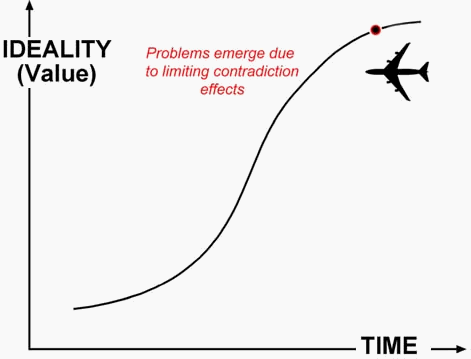
figure 2.1 - super-system s-curve
For such a mature stage, the following sequence of tools is recommended[1] :
Contradictions
Trends
Ideality
Contradictions
The aircraft fuselage is a highly optimised system - most of the available space has been utilised and therefore available floor area problems arise for passengers due to this volume restriction in the cabin. A relevant super-system contradiction is therefore:
Improving feature: 5. Area of moving object
(i.e. usage of area of floor)Solutions from the contradiction matrix:
7. Nested Doll
14. Spheroidality
17. Another dimension
4. Asymmetry
Interpretations of inventive principles included the following:
Asymmetry
Asymmetry was found to be the most useful and productive trigger of the four solutions suggested. The aircraft cabin is a highly symmetrical system and it follows that by experimenting with asymmetry many interesting and novel solutions are discovered.
The starting point is a standard seat layout with all seats arranged in rows facing forwards (6 seats are shown, figure 2.2, No 1).

figure 2.2
Introducing asymmetry (No 2) is beneficial since facing passengers can ‘share’ legroom and have more space. Increasing asymmetry by offsetting the facing rows such that the legs will mesh (No 3) solves problems due to the clashing of knees across opposing passengers. Hence, the shape occupied by each person improves and it is easy to imagine how this intelligent use of the available space may have increased benefits.
If this layout were deployed in a familiar straight row manner, one seat is lost per row due to the wasted space at the end of each row caused by offsetting the seats (equating to around 45 fewer seats in a 747 - an unacceptable loss). Extending asymmetry principles to the aisle helps to overcome this.
Figure 2.3 shows that other layouts can be achieved by altering the asymmetry further. However, any added value over previous schemes is countered by an increase in complexity.

figure 2.4
Another dimension
The layout of seats in an aircraft is usually imagined in plan view (as above), thus ignoring the third dimension, height. Although the contradiction matrix suggests that this might be exploited, the creation of concepts is greatly hindered by constraints on the absolute height within the cabin. Thus, any solutions whereby passengers are tessellated in the vertical plane soon prove unachievable except if the ‘lay the object on its side’ trigger is employed: From this it was decided that a segmented sleeping section of the plane could incorporate ‘sleeping capsules’ similar to those found in Japanese ‘capsule hotels’ (figure 2.5), since passengers can be tessellated more ideally whilst lying horizontally.
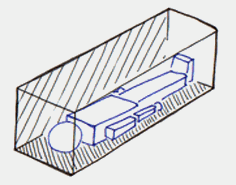
figure 2.5 - sleeping capsules
Nested doll
The ‘nested doll’ inventive principle implies the movement of objects in relation to or inside one another, or, more abstractly, if space has already been used once, the key to solving the comfort problem might lie in using it twice.
A typical 10-abreast economy seating arrangement from a Boeing-747 is shown in figure 2.6. The gap in front of each seat is highlighted in yellow and the aisle in orange. All seats face forwards.
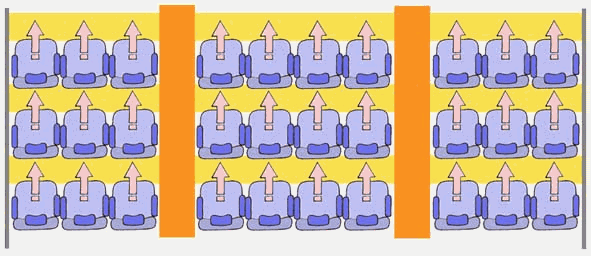
figure 2.6
The gap in front of each seat and the aisle can be combined by seating the passengers sideways. Unfortunately, anybody using the aisle would have to pick his or her way through a long row of legs- a clear disadvantage. This may be solved, however, by re-applying the ‘another dimension’ trigger and raising the aisle. The legs of passengers are accommodated underneath (‘within’) the aisle (figure 2.7).
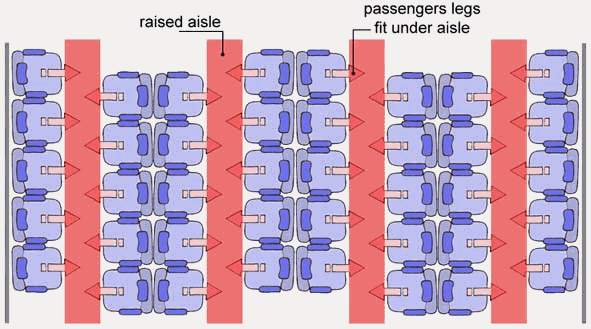
figure 2.7
Some benefits of this scheme are:
greatly increased legroom - legs can extend to underneath the opposite seat on reclination (figure 2.8)
instant access to/from aisle - accessing the toilet causes no disturbance to others, exercise becomes easier
improved access to passengers for cabin crew - only minimal reaching required
four aisles rather than two- decreased evacuation time, more space for exercise, decreased blockages
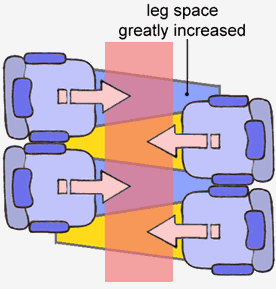
figure 2.8- top view of 4 seats
Notably, this layout displays three of the four inventive principles suggested.
Trends
A mono-bi-poly trend was recognised in that functions offered by ‘cabin components’ such as lounges, bars, restaurants etc. have become merged with that of the passenger seat over time. Passengers nowadays typically sleep, work, and are entertained in their chairs. An example of how further developments might be made, is passengers ‘preparing’ their own food (by bringing it onto the plane from a selection in the waiting lounge or by pre-storage of food in food-tray vacuum cavities) and thus allowing removal of the galley. This can be seen as an example of trimming (figure 2.9).
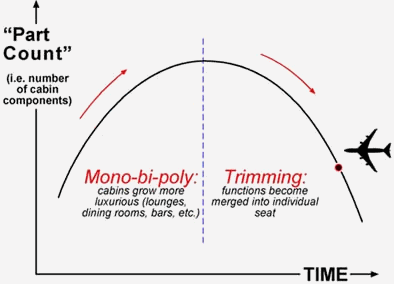
figure 2.9 -trimming
Ideality
The ideal final result tool (IFR) was deployed, with the use of the five questions to overcome psychological inertia, as follows:
What is the final aim?
to improve the level of comfort for long haul flight
passengers
What is the ideal final result?
if all passengers had enough space to be comfortably
accommodated
What is the obstacle to this?
for ticket costs to be kept at a minimum, airlines must
fill their flights with as many fare-payers as possible
Why does this interfere?
as there are so many passengers, the amount of space for
each reduces and the seats become cramped
Under what circumstances would the interference disappear?
- IFR1. If there was enough space for all passengers to be asleep
- IFR2. If the passengers were easier to tessellate
- IFR3. If passengers all knew each other they could share their personal space and use it more effectively
- IFR4. If the seats didn’t take up so much of the available space
- IFR5. If passengers were able to stretch and exercise more
- IFR6. If the seat was more adjustable to the passengers’ body, the limited volume available would be less significant
- IFR7. If there was a gap in front of each passengers’ seat to accommodate their legs
The ideal final results above are from simple brainstorming. An example of how they are executed based on the idea of defining an IFR and working back to the current situation is shown in figure 2.10 below:
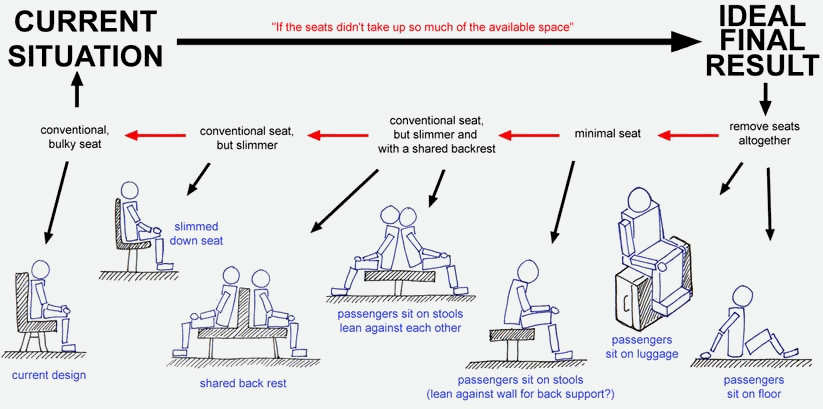
figure 2.10
3. ‘SYSTEM’ LEVEL
Development of the aircraft seat itself has not been extensive by any means. What started as a bamboo or wicker chair has evolved only so far as an aluminium frame covered with foam padding, and this has remained the same for perhaps twenty years. This increase in strength of the chair has largely been a response to tightening safety regulations.
The system-level ‘seat’ s-curve remains in a position of neither infancy or maturity, and problems have emerged because the function is not being satisfactorily delivered: many can sympathise with the annoyances caused by cramped leg room, limited width for the hips and inadequate back support during long flights.
Presented with this situation, TRIZ knowledge[1] is vague in that it states that the sequence of tools is probably unimportant. Using experience a less random approach was devised:
Trends -since evolutionary information is easy to extract from research
Knowledge - to see if the function can be/has been achieved in other ways
Contradictions - if they exist they can be tackled
Other tools - as/where appropriate.
The study of the ‘system’ level of the passenger cabin is interesting because the use of the various tools can be shown to produce similar results, perhaps suggesting an indication of their validity. Below are some of the potentially useful design directions identified
Trends
Beginning with a standard airline seat made of aluminium and covered with foam blocks, a trend of increasing dynamisation is instantly recognisable.

Since the current seat design has only developed insofar as gaining a single joint in the form of a pivoting backrest, the scope for improvement suggested by trends is considerable. A number of concepts around the basis of improved dynamisation can be imagined, each with benefits over those offered by existing designs:
A many jointed seat to better adapt to the passengers body
An ‘elastic’ mesh seat for greater comfort
Liquid, gel or air-filled seats for ‘infinite’ adaptability
Investigating the opportunities presented by adding more joints alone produces many interesting solutions (figure 3.1)

Figure 3.1- chair dynamisation
Knowledge
The knowledge tool was applied by researching where the desired function (“comfortable seating”) might have been delivered successfully in another application. The notion of comfort is perhaps subjective, but by considering office chairs, bean-bags and even bicycle saddles, knowledge correlates exactly with what trends tells us about the dynamisation of seats by utilising mesh, polystyrene balls and gels respectively. A mesh seat has the added advantages that it is much less bulky than the conventional seat, so providing more space for the passenger, and also that it will weigh less and prevents the build up of moisture/heat.
These conclusions are similar to those of the British design consultants Seymour-Powell[2], whose recent study of the airline seat produced a lightweight mesh-based design (figure 3.2) which also incorporates a new ‘sliding’ reclination method whereby the knees of the passenger behind are less affected.
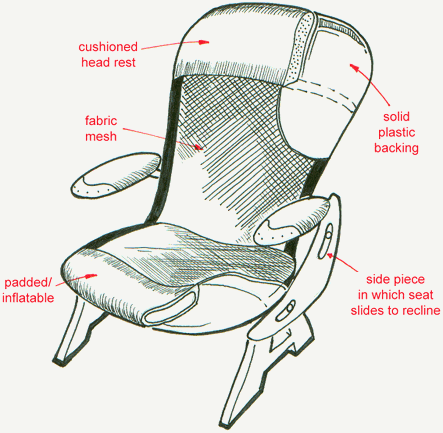
Figure 3.2- Seymour-Powell design
Contradictions
TRIZ was also used at the system level to optimise the solutions suggested in the super-system analysis. An example of this is with the ‘sleeping capsules’ (figure 2.5).
It occurs that a uniform rectangular capsule is not ideal to house a non-uniformly shaped passenger. Applying asymmetry to the capsules in a similar manner to that used to solve the super-system contradiction is useful (figure 3.3). N.B. The red arrow shows the point of entry/exit to the capsule and is the end that accommodates the passenger’s head.

Figure 3.3 - top view of adjacent cabins
Whereas it is not necessary for the leg-end to be wide, the extra width provided at the head-end by doing this would greatly aid the feeling of comfort and reduce the tendency for claustrophobia whilst also allowing individual capsules to be more usefully tessellated within the fuselage.
Hand luggage might be stored above the passenger’s legs within a cabin of asymmetric shape (figure 3.4), but access to the luggage from inside the limited cabin space is awkward. The contradiction is:
Improving feature: 23. Waste of substance
Worsening feature: 33. Convenience of use
Solution from the contradiction matrix:
2. Extraction
The extraction solution, whereby the luggage above an occupant belongs not themselves but to the person in the adjacent capsule, greatly improves access to the hand luggage (figure 3.5).
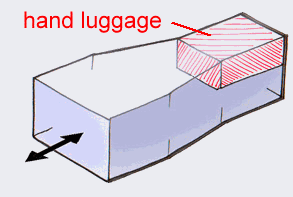
Figure 3.4 - position of hand luggage
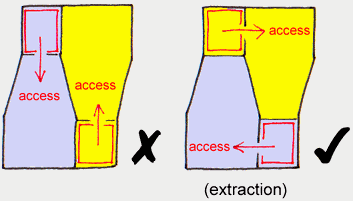
Figure 3.5 - extraction method
(Analyses of the seat sub-systems and their possible improvement using TRIZ are contained in the full report available from the University.)
Conclusion
The judgement of individual solutions is a long-winded process that is in any case difficult without the use of appropriate models, analysis and simulation. From an ideological perspective though, TRIZ can be used to determine whether the ‘value’ of the system has been increased, where:

‘Success’ can therefore be defined as any worthwhile increase in the value of the system, when either the benefits increase, or the ‘costs + penalties’ decrease.
The majority of solutions suggested by TRIZ during the investigation exhibited an increased value in this manner, and the reader is invited to draw their own conclusions about the individual solutions presented.
In any case, it was shown that the aircraft cabin super-system is highly optimised and problems emerge due to the limits on absolute volume within the fuselage. The system, however, is less optimised and various opportunities for advancing the technology using ideas suggested by TRIZ are available. Problems here emerge largely because of problems adapting the seat to the passenger’s body.
Evaluation of TRIZ
Of perhaps more significance from an academic perspective is a discussion of the effectiveness of TRIZ.
In simple terms, where TRIZ was required to solve problems that were put to it, the solutions produced were reasonable, practical and useful, and therefore it was thought that the application of TRIZ to economy flight cabins was a justifiable exercise.
Constraints
This report has concentrated on the idea generation aspects of TRIZ rather than the downstream ‘idea evaluation’ parts. During the evaluation elements of the actual project, various social and legislative constraints (CAA/FAA certification issues, etc) were brought to bear on the ideas developed earlier. These constraints will inevitably have a bearing on any eventually practicable solutions emerging from the work.
The work conducted deliberately sought to keep constraints out of the picture until after the idea generation process was over. This was done in line with the way our brains work - the act of ‘creation’ using a physically different part of the brain to that used for ‘evaluation’[4].
In purely ‘creative’ thinking mode, then, TRIZ assumes that the system components have the freedom to be altered in any way necessary to accomplish the solution (for example, re-orientation, separation, thermal expansion etc.). Although acceptable for most simple mechanical systems, these principles cannot always be applied to humans, and it was thus very difficult to put aside the conditioning of many years of inherently building these ergonomic considerations into the creative process. The simple answer to this would be to build constraints into the TRIZ process before the idea generation mode is entered, but this would in turn be fraught with difficulties and hazards.
There is no obvious solution to this ‘constraint management’ process, and this is felt to be an area where TRIZ could be improved. It would seem that this is the sort of area in which the ‘hard’, structured approach of TRIZ would benefit from the incorporation of some of the findings of psychology-based creativity research.
Overall, for this project, ignoring the constraints was found to be detrimental to the use of the contradictions tool, but, interestingly, was found to be essential for the adequate operation of the ideal final result tool. In fact, Virgin Atlantic have used a method similar to ideality which they call ‘preferred futuring’[5].
Formulation of Contradictions
In certain circumstances it was found that ‘correctly’ formulating the contradiction for a problem such that a useful solution could be obtained was difficult. Experience is clearly an advantage when formulating contradictions in an explicit manner, and the guidance of someone with considerable contradiction-formulating expertise was, at times, essential. It is thought that relatively inexperienced problem owners attempting a similar investigation without this level of support face a formidable challenge. Additionally, the benefits of using TRIZ in pairs can be imagined. Experience was also necessary where TRIZ knowledge is vague in deciding which tools to use. An alternative approach is of course to use all of the tools available, but this tends to dilute the consideration given to each method.
‘Flexible Shells and Thin Films’
The TRIZ methodology is being continually revised as new developments emerge. During the system analysis, a dynamisation trend proposed that a seat using mesh to support the occupant would be an improvement. Seymour-Powell also recognised this, and the advantages are clear: support is improved, the seat occupies less space, moisture and heat build up are reduced, etc. Flexible shells and thin films clearly offers a very effective solution direction for the airline seat problem. However, the inventive principle was not returned when any of the possible contradiction combinations that this solves - volume vs. adaptability, strength vs. weight, object generated harmful factors vs. weight, etc - is referred to in the matrix. The use of this principle in solving the above contradiction suggests that there is a case for updating the method accordingly - a worthwhile outcome from the investigation, and something that concurs with previous analysis of how biological systems solve similar problems[6].
Overall
Perhaps the most interesting conclusions, however, are shown when comparisons between this research and other investigations are made.
The work of Seymour-Powell is the most relevant recent study uncovered on the issue of economy seating in aircraft. They were asked by Swissair management to somehow improve on-board comfort for their passengers, and naturally set to on redesigning the seat. It is believed that by completely ignoring the real cause of fundamental problems within the cabin, that of the configuration and nature of the passenger seating, a classic case of inadequate problem definition was experienced.
Indeed, at the system level many of the TRIZ tools do point towards the type of chair that Seymour-Powell suggested. Whether this is significant because Seymour-Powell were able to produce the solution without the help of TRIZ or because a relatively inexperienced user has been able to derive the same designs as two experienced design consultants is arguable. Both studies do at least concur that this is how the state of the art should proceed.
This investigation may be notable as it acknowledges the fact that the configuration of the seats is primarily to blame for the discomfort of passengers and attempts to address this. The most important concepts developed are therefore those from the super-system analysis. Indeed, to the passenger with a choice of airlines, the factors affecting his/her decision will increasingly be based around super-system features, i.e. legroom, access to aisle, amount of seat recline, etc., as opposed necessarily to features of the system.
Acknowledgements
The support and encouragement of both Darrell Mann and Dr. Glen Mullineux at the University of Bath is gratefully acknowledged, as is the assistance and advice kindly offered by Don Masingale at Boeing.
References
[2] “Better by design” (video), Channel 4 Next Step, in assoc. with the Design Council
[6] Darrell Mann, “Creativity As An Exact (Biomimetic) Science”, Biomimetics IV, Reading, September 1999.